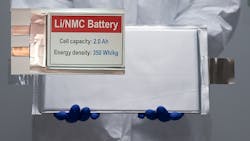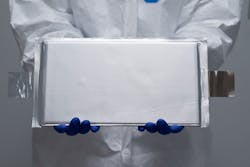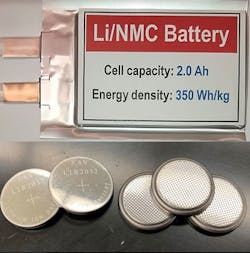Lithium Wars: Solid-State Batteries Vie with Wet Chemistries in Race to Market
What you'll learn:
- Two evolutionary new developments in battery technology.
- Successful tests on a 40-Ah solid-state battery prototype.
- A higher-capacity lithium-metal battery.
The humble battery, once considered a mature (i.e. boring) technology, has become a hotbed for innovation and investment as new storage technologies compete to see which will lead the transition to a vibrant renewables-based global economy. Two recent developments add further intrigue to this sector.
The first is Pacific Northwest National Laboratory’s announcement of a dramatically improved version of the conventional lithium-ion cell structure. The second is a startup involved with solid-state storage technology coming out of stealth mode to announce what appears to be a prototype of a high-capacity commercial product. If they prove to be viable, these developments may be part of the toolkit we need to fast track the de-carbonization of the economy for future generations.
Solid-State Moves Ahead
Solid-state batteries, which replace the gel or liquid electrolytes used in Li-ion cells with a solid material, hold a lot of promise for higher power densities and longer life, but they are a relatively new technology. Several startups, including Solid Power, are in the process of mastering the same steep learning curve that Li-ion batteries went through before they can be a commercial commodity.
Now, Factorial Energy, a relative newcomer to the market, may have shortened solid-state's anticipated time to arrival to the market: The company announced its successful tests on a prototype that packs 40 amp-hour (Ah) worth of capacity. Results of capacity-retention testing on its 40-Ah solid-state cell technology were hailed by Factorial as a “breakthrough,” saying that the initial round of cell cycle behavior testing at 25°C demonstrated a 97.3% capacity-retention rate after 675 cycles.
Details on the battery system, which Factorial says was developed in conjunction with several of the world’s largest auto OEMs and cell manufacturers, are scarce. However, some details were revealed when the 40-Ah cell was originally announced in late April 2021, along with its Factorial Electrolyte System Technology (FEST).
The company says that its proprietary solid-electrolyte material enables safe and reliable cell performance with high-voltage and high-energy density electrodes. It also claims that FEST is safer than conventional lithium-ion technology because it replaces the combustible liquid electrolyte with a safer, more stable solid-state electrolyte that suppresses lithium dendrite formation on lithium-metal anodes.
Factorial says that, thanks to these properties, battery platforms based on FEST yield 20-50% improvements in driving range without sacrificing pack longevity. Furthermore, they surpass prevailing EV battery performance standards, including those for energy density, cycle life, and safety.
These promising cell performance results hint at the technology's potential and are a good sign that the company is one step closer to a commercial product. Meanwhile, the company says that it’s engaged in active discussions with several automakers on supporting the research and manufacturing of EV battery cells.
Factorial and its competitors appear to be on track to making solid-state batteries a commercial reality within the decade. As reported by Electronic Design, Solid Power announced similar relationships with BMW Group and Ford late last year, and both companies will get full-scale 100-Ah cells for automotive qualification testing and development of upcoming vehicles beginning in 2022. The automakers have agreements to use the technology in upcoming electric vehicles that will arrive by 2030.
New Electrodes for Old Batteries
While solid-state batteries may replace "wet" Li-ion cells in the long run, the question remains whether ongoing improvements in conventional Li-ion technologies, such as a recent development at U.S. Department of Energy’s Pacific Northwest National Laboratory (PNNL), will extend their market dominance far longer than the upstarts expect.
PNNL's research has been focused "lithium-metal batteries" (versus today's lithium-ion cells), which replace the carbon used for the electrodes in conventional Li-ion cells with lithium. These have long held the promise of delivering almost twice the energy of their widely used lithium-ion counterparts, as well as being lighter. Until now, though, lithium-metal batteries in the laboratory have been plagued by a phenomenon known as “premature death,” causing them to sustain only a fraction of the charge cycles and shelf life of today’s lithium batteries.
The research conducted by PNNL's scientists to improve lithium-based battery cells has paid off in the form of a new, higher-capacity, longer-life all-lithium cell structure. As originally reported June 28 in the journal Nature Energy, their lithium-metal battery boasts an energy density of 350 watt-hours per kilogram (Wh/kg) and lasts for 600 cycles while retaining 76% of its initial capacity.
Much of this improved lifetime is due to a new anode structure that creates arrays of extremely thin, precisely deposited lithium threads, roughly 20 microns wide. The resulting structure enables very high energy densities and is very resistant to the failure modes that afflict lithium-metal chemistries (see “Why Thickness Matters” below for details).
There’s still work to go, however, before the technology can be commercialized. Although PNNL's lithium-metal batteries have much higher capacity than the Li-ion cells used in today's EVs, their 600-cycle lifetime is much shorter than today's battery packs that typically last at least 1,000 cycles. But, if the steady improvements delivered by the team over the past few years continue, the technology should be ready to commercialize well before the time comes for solid-state battery technology.
Just four years ago, an experimental lithium-metal battery could operate for 50 cycles. That has increased rapidly: Two years ago, the PNNL team achieved 200 cycles—and now 600. Moreover, the PNNL battery is a pouch cell, which more closely mirrors real-world conditions than does a coin cell, a less realistic type of device used in many battery research projects.
Lithium Metal: Thin Strips of Lithium Translate to Longer Lifetime
The PNNL team found a way to increase the battery’s lifetime by developing a unique structure that’s less susceptible to failure. Instead of using anodes with more lithium, the team used incredibly thin strips of lithium measuring just 20 microns wide—far thinner than the width of a human hair.
“Many people have thought that thicker lithium would enable the battery to cycle longer,” said Jie Xiao, who co-authored the paper with Jun Liu, the director of the Innovation Center for Battery500 Consortium. “But that is not always true. There is an optimized thickness for each lithium-metal battery depending on its cell energy and design.”
Why Thickness Matters
The team’s decision to try thinner lithium strips was based on its detailed understanding of the molecular dynamics of the anode. As explained in the Nature Energy paper, the scientists discovered that thicker strips contribute directly to battery failure. This is due to complex reactions around a film on the anode known as the solid-electrolyte interphase, or SEI.
The SEI is the byproduct of side reactions between lithium and the electrolyte. This region acts as an important gatekeeper that allows certain molecules to go from the anode to the electrolyte and back again while keeping other molecules that can deteriorate the cell's chemistry at bay. Creating an SEI that reduces or eliminates these unwanted side reactions between the electrolyte and the lithium metal that deteriorate the cell's chemistry has been an important but elusive goal for researchers.
The team found that thinner lithium strips are adept at creating what one might call “good SEI,” while the thicker strips have a higher chance of contributing to what could be considered “harmful SEI.” In their paper, the researchers use the terms “wet SEI” and “dry SEI.” The wet version retains contact between the liquid electrolyte and the anode, making important electrochemical reactions possible.
Dry structures, on the other hand, prevent the liquid electrolyte from reaching all of the lithium. They learned that with thicker lithium strips, the electrolyte needs to flow into deeper pockets of the metal, and as it does so, it leaves other portions of the lithium dry. This stops important reactions from occurring, effectively smothering necessary electrochemical reactions and contributing directly to the early death of the battery.
To see the figure above in action, click here.
The unwanted reactions that form in dry SEI conditions are analogous to how a frying pan gradually builds up a layer of grease if not cleaned thoroughly after each time it’s used. Over time, the layer builds up and acts as a barrier, reducing the flow of energy and making the surface less effective. In the same way, an unwanted, dry SEI layer prevents the effective transfer of energy needed inside a battery.
Electrolyte starvation is an important issue, especially in realistic batteries, such as pouch cells, where the amount of electrolyte available is 20 to 30 times less than that used in experimental coin cells. Further improvements based on the PNNL research team's current work are expected to steadily increase the lifetimes of subsequent generations of cells, bringing them much to the point where they can be commercialized.
About Battery500
The new research was done through the DoE’s Innovation Center for Battery500 Consortium, a multi-institution effort led by PNNL to develop electric-vehicle batteries that are lighter, more energy intensive, and less expensive than those currently used. PNNL leads the consortium and is responsible for integrating the latest advances from partner institutions into devices known as high-energy pouch cells and demonstrating improved performance under realistic conditions.
The progress on lithium-metal batteries has been substantial, thanks to the Battery500 Consortium. The goal is to increase the amount of energy packed into a long-duration, safe, affordable battery. More energy per pound of material translates to a lighter vehicle that can go farther on one charge. Today’s EV batteries are in the neighborhood of 200-250 Wh/kg; Battery500 is aiming for a cell level of 500 Wh/kg.
“The Battery500 Consortium has made great progress in increasing the energy density and extending the cycle life,” said Distinguished Professor M. Stanley Whittingham of Binghamton University, the 2019 Nobel Prize laureate in chemistry and a coauthor of the paper. “But much more needs to be done. In particular, there are safety issues with lithium-metal batteries that must be addressed. That’s something that the Battery500 team is working hard to resolve.”
The work was funded by DoE’s Office of Energy Efficiency and Renewable Energy’s Vehicle Technologies Office. Much of the microscopy to evaluate the battery was done at EMSL, the Environmental Molecular Sciences Laboratory, a DoE Office of Science user facility located at PNNL.
In addition to Liu, Xiao, and Whittingham, authors include PNNL scientists Chaojiang Niu, Dianying Liu, Joshua Lochala, Cassidy Anderson, Xia Cao, Mark Gross, Wu Xu, and Ji-Guang (Jason) Zhang. Xiao and Liu also have appointments at the University of Washington.



